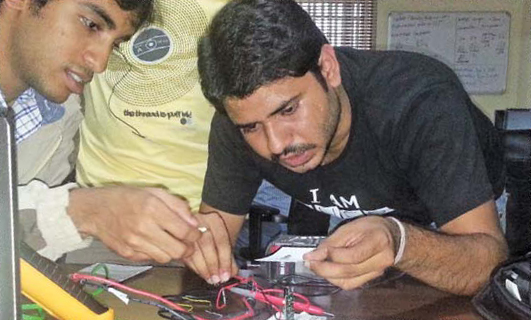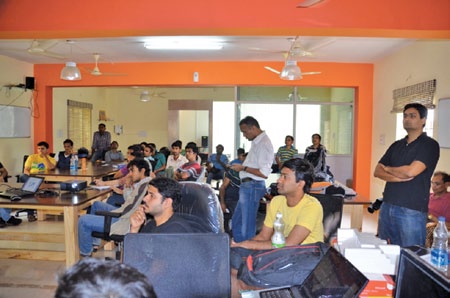Have you ever seen little children, who have just learnt to sit up, grabbing a ball-point pen from their dad’s pocket, disassembling it and trying to put it together again? Do you let them meddle, or do you grab that pen, stash it back into your pocket and walk off? Well, this is the earliest sign of the do-it-yourself (DIY) craze in a person. Fostering it could transform the child into an innovator, an entrepreneur or simply a very resourceful person with unending excitement all lifelong!
While DIY exists in almost everything from music and crafts to plumbing and carpentry, it is especially interesting, developmental and community-oriented in technical fields like electronics and robotics. Here we attempt to figure out what makes electronics DIY so interesting and purposeful, how people go about it (is there a standard ‘route’), what they need and where they get the stuff, what boards or components they prefer, and how vibrant the community is in India.
Why DIY?
Jayakrishnan T., CEO of Asimov Robotics, is a robotics DIYer who later built a company around his passion. He feels that very few people go the DIY route for cost-saving because DIY costs time and for most people that is more valuable than money. Most people do it because they are passionate about it. A lot of people walk down the DIY path to familiarise themselves with something they have always been apprehensive of doing, or they do it to quickly get something that is not readily available. Many a times, a DIY project might revolve around modifying or upgrading an existing solution to satisfy a specific need or to fix a problem associated with the solution.

This resonates with the thoughts of Nagasai Panchakarla, entrepreneur and co-organiser of a Bangalore-based Internet of Things DIY group (IoTBlr). Nagasai feels that “DIY is all about creation. In order to create something, DIYers will come across a lot of questions for themselves and explore their own potential… questions like what do I know, what do I not know, what resources do I have, who will work with me and how to get things done from constrained resources. This will bring in the entrepreneurial mindset of converting imagination into a product that one loves.”
Ken Denmead, popularly known as GeekDad Ken in the cyber-world, and editorial director of Maker Media, feels that the biggest positive aspect of DIY projects is empowerment. People should be connected to the things they own and use, and helping people feel empowered to make things themselves helps them achieve those connections,” he explains.
Nihal Kashinath, IoT enthusiast and founder of IoTBlr, feels that DIY results in democratisation of technology and design, which is a wonderful thing. Anyone can create anything, and no one needs to be satisfied with the products or specifications put forth by large-scale manufacturers, which, for commercial reasons, would usually cater to the lowest common denominator of their common market.

“With affordable electronics, 3D printing, support of the DIY community, etc, soon everyone will be able to make or modify things to meet his specific requirements,” says Kashinath.
“DIY projects have a psychological connect with the task at hand. The sense of achievement from making something yourself cannot be replicated in any other way. In addition, people learn faster from ‘hands-on’ experience and the knowledge gain is better than when watching somebody else doing it. Besides, DIY enables mass customisation and increasing personalisation as consumers become more demanding. This is a big motivation for DIY projects,” says Rajiv Bajaj, head-Manufacturing, Autodesk India & SAARC.
“It is amazing to see how individual entrepreneurs and design enthusiasts are becoming manufacturers themselves. This increasing affordability and accessibility has facilitated the rise of the ‘maker community.’”
A DIY trend may also be fostered to promote new technologies, as we can see from the example of the IoT-focused DIY group. “The IoT presents a new opportunity to the DIY community. It is an entirely Greenfield area of innovation where large organisations and individuals or DIY groups have similar levels of maturity. Platforms like the Arduino, MSP430 Launchpad and Raspberry Pi have democratised innovation and reduced the barriers to entry significantly, so even a high-school student with interest can get started making interesting projects or devices. Let us not forget that many great companies started as projects nurtured by the DIY community. One often-quoted example is the birth of Apple and its close connection with the Homebrew Computer Club,” says Sayan Chakraborty, a core member of IoTBlr, who is leading the effort to set up a physical hackerspace for the group.
Getting started—the first steps
Bajaj explains how it is done: “Every DIY effort starts with planning the course of action. Like any other planned activity, DIY projects start with ideation followed by budgeting, procurement of materials, cost management and finally execution. The scale of the project simply defines how much time and effort is required at each stage before final execution. A crucial stage of DIY is digital prototyping that is enabled by technology. The benefit of prototyping is that it helps to minimise errors and ensure desired results at the project planning stage. Any project that is evaluated well on these parameters can be converted into real objects.”
The steps, of course, vary from person to person and project to project. Randy Sarafan, technology editor, Instructables, says, “I typically start with a spark of inspiration, and then immediately write it down (otherwise, I will never remember it). This is preceded by brainstorming, sketching, acquiring parts and general pre-planning. Some of the more complicated projects might also have a more formal design phase where the project is planned out using design software. From there I typically breadboard the circuit to make sure that it works as intended. Once I am happy with that, I build the project, stopping at the end of every new alteration to take a picture of the process. Finally, when the build is complete, I compile all of the pictures, software and circuit diagrams and write step-by-step instructions for others to be able to learn from what I have done. Even if I never iterate upon the design and make a second version, perhaps someone else can do that or apply what I have learned to their own efforts.”
Deciding what you need
“The barebones minimum set of tools one might need would be a soldering iron, breadboard, wire stripper and multimeter. Beyond that, the next big tool to invest in would be an oscilloscope. In the last few years prices of these tools have gone down considerably, and you can now find a pocket-sized digital scope for under $100. This puts this tool well within the reach of individual inventors,” suggests Sarafan.
[stextbox id=”info” caption=”The steps from idea to product, the DIY way”]• Conceptualise
• Brainstorm
• Sketch
• Assess parts, tools, materials
• Acquire these
• Design/plan steps
• Rough build/ breadboard
• Build (take photos of each step)
• Test
• Fine-tune
• Compile and upload all instructions and pictures for the community to improve upon[/stextbox]
As for the software needed, Denmead says, “It all depends upon what you are basing your build around. VEX Robotics and LEGO Mindstorms EV3 have their own programming software. Alternatively, if you’re building a robot using an Arduino brain, you’d use the open source programming tools available for it.”

So when you choose components for your project, remember Denmead’s thumb rule: “Be aware of what you need, and what’s available to fit that need. You may not need the most expensive item for your project, and if you do your research, you can save some cost.”






